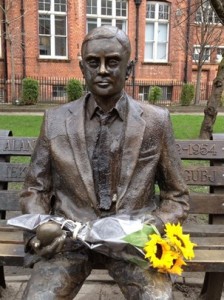The Manchester Science Festival (UK) has organized a citizen science project in honour of the 100th anniversary of Alan Turing’s (Wikipedia essay) birth (from the essay [Note: I have removed links and bibiographic references]),
Alan Mathison Turing, OBE, FRS (… TEWR–ing; 23 June 1912 – 7 June 1954), was an English mathematician, logician, cryptanalyst, and computer scientist. He was highly influential in the development of computer science, providing a formalisation of the concepts of “algorithm” and “computation” with the Turing machine, which played a significant role in the creation of the modern computer. Turing is widely considered to be the father of computer science and artificial intelligence. He was stockily built, had a high-pitched voice, and was talkative, witty, and somewhat donnish. He showed many of the characteristics that are indicative of Asperger syndrome.
Here’s more about the project, thanks to the GrrlScientist April 16, 2012 posting on the Guardian Science blogs,
What do sunflowers and Alan Turing share in common? Basically, Turing noticed that the number of spirals in the seed patterns of sunflower heads often conform to a number that appears in the mathematical sequence called the Fibonacci sequence (0, 1, 1, 2, 3, 5, 8, 13, 21, 34, 55, 89…). Other plants also show this pattern. When Turing came to the University of Manchester, he began exploring how this phenomenon might help us to understand the growth of plants, a field now known as phyllotaxis.
Tragically, Turing died before his work was complete, so the Manchester Science Festival is asking for you to help mathematicians explore Turing’s ideas about plant growth.
This video on the GrrlScientist posting (there are other related videos in the posting) by Brady Haran, the video journalist who amongst other projects films the Numberphile series, explains Turing’s interest in sunflowers and Fibonacci’s spiral,
You don’t have to be a mathematician to join in although it seems that it’s best if you’re in Manchester (the festival doesn’t specify residence there as a requirement), from the Turing’s Sunflowers webpage on the Manchester Science Festival website,
This spring, we need your green fingers! Join Manchester Science Festival and MOSI (Museum of Science & Industry) for a mass planting of sunflowers as part of an experiment to solve the mathematical riddle that Turing worked on before his death in 1954.
…
Brighten up Manchester and the Nation, whilst helping mathematicians to explore Turing’s theories about plant growth. We need you to sow sunflower seeds in April and May, nurture the plants throughout the summer and when the sunflowers are fully grown we’ll be counting the number of spirals in the seed patterns in the sunflower heads. Don’t worry – expertise will be on hand to help count the seeds and you’ll be able to post your ‘spiral counts’ online.
The results will be announced during the Manchester Science Festival 2012 (27 Oct – 4 Nov), alongside a host of cultural events connected to Turing’s life and legacy, at MOSI, Manchester Museum and other cultural spaces.
You can find out more about the Manchester Science Festival, which runs from Oct. 27 – Nov. 4, 2012, here.
Although they don’t identify it on the Turing’s Sunflowers webpage,I’m pretty sure this is a bronze of Turing seated on a bench. Someone has thoughtfully given him a bouquet of sunflowers,

Bronze of Alan Turing in Manchester. (downloaded from http://www.manchestersciencefestival.com/connect/getinvolved/sunflowers)
Have fun!